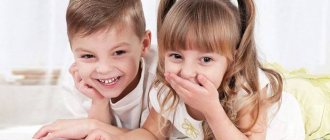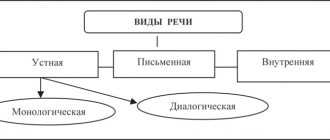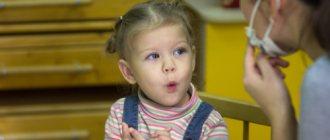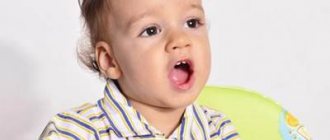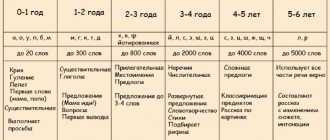At an early age, children learn about the world around them with interest, and a child’s speech at 3 years old is an important component. It is very important for parents to monitor the development of the baby and the assimilation of new information. At this age, the baby should speak clearly, even if he cannot yet pronounce complex sentences. By the age of four, speech should be rich in pronouns and adjectives that allow one to describe the properties of surrounding objects. Speech development for children at this age is extremely important, so it is important to eliminate any defects.
The development of speech in children aged 3-4 years is characterized by the following features: the child speaks clearly, albeit indistinctly, repeats the words he hears, can compose simple sentences, and can compose a short retelling.
Delayed speech development in children 3 years old: causes
Before you start worrying and looking for symptoms of speech development delay (SSD) in your baby, take into account the following: a child’s speech development is a rather individual process.
If your friend’s three-year-old child recites poems from memory, but your baby is silent, this is not a reason to sound the alarm. This is a reason to take a closer look at your baby and his behavior. In addition, the baby will have to undergo a medical examination and, most likely, change his usual leisure activities.
Don’t forget, the concept of “speech” is different for specialists and average parents! Experts distinguish between the passive and active phases of speech, while for parents speech is a speaking skill. If everything is fine with the child’s passive phase of speech, then you need to be patient and wait a little.
And now about the reasons for ZZR. They are biological and social in nature.
Biological:
- Presence of minimal brain dysfunction (MCD). This is a very popular diagnosis today, which is not included in the International Classification of Diseases. Translated into ordinary language, a diagnosis means that there is a certain combination of symptoms indicating that the brain is doing its job a little differently from what is written in smart medical books. The causes of MMD can be: problematic pregnancy and difficult childbirth, frequent illnesses in infancy with their severe course, complications after vaccinations, and traumatic brain injuries.
- Hearing loss.
- Genetic predisposition.
- Presence of cerebral palsy, early autism, Down syndrome, hyperactivity syndrome.
Important: It has been proven that modern children begin to speak later than their peers 20 years ago. The explanation is quite banal: modern children switch to solid food too late. Remember: chewing is the best exercise for the muscles of the speech apparatus!
Social/pedagogical:
- Unfavorable social environment. Alas, in this case we are talking about a lack of communication, which is observed, among other things, among children from prosperous families.
- Emotional stress.
- Bilingualism.
- Overprotection.
- Over-informed environment.
Night terrors: why they happen and what to do about them
What are nightmares
Nightmares are sleep disturbances in which a child may suddenly cry, scream, moan, or mutter in bed with eyes wide open but not awake. Because she is stuck in a sort of twilight zone between sleep and wakefulness, she is unaware of your presence and is unlikely to respond to anything you say or do. The episode lasts anywhere from two to 40 minutes, and when it ends, your child suddenly goes back to sleep with no memory of the incident.
How are nightmares different from night terrors?
Sixtine fights a monster in her bedroom in Laure Fauvel's “Terreurs”, 2014, in Paris, France.
An imaginative photographer has brought to life monsters that haunt children's nightmares. Armed with sticks, wands and swords the eight and nine year-olds appear to be getting the upper-hand against the villains. Parisian photographer Laure Fauvel, 22, said: I wanted the children not to be victims and to fight the monsters. (Photo by Laure Fauvel/Barcroft Media) Unlike a night terror, a nightmare leaves your child truly awake—she can remember the dream and sometimes talk about it. In addition, children have nightmares during sleep, often in the early morning hours between 2 and 6 am. On the other hand, they usually experience night terrors in the first few hours of the night during deep, dreamless sleep.
The easiest way to tell the difference between a night terror and a nightmare is to ask yourself who is more upset that morning. If your child is more agitated, he had a nightmare. If you're the one who's concerned, she probably had a night terror. The “horror” lasts much longer for the parent who observed it than for the child who experienced it.
What causes nightmares and can they be prevented?
There is no definitive way to prevent nightmares because no one knows for sure what causes them. Nightmares can occur due to erratic or inadequate sleep patterns or any type of sleep deprivation. They are caused by stress during the day or excessive fatigue. What will be known is that, by themselves, nightmares do not mean the child has a psychological problem.
Addressing any other sleep problems your child has (such as getting up in the middle of the night) and ensuring they have regular, calming bedtimes and get enough hours of sleep can help prevent night terrors. In some cases, nightmares are caused by sleep apnea, a serious but treatable disorder in which enlarged tonsils and adenoids (normal tissue in the throat) block the airway during sleep, making breathing difficult and causing the child to become partially awake.
Delayed speech development in children 3-3.5 years old: drug treatment
Important: any self-medication is dangerous! Treating a child with medications without a specialist’s instructions is a crime!
If your baby does not speak and there is no positive dynamics in his development, then you should contact a group of specialists. Be sure to consult with
- a pediatrician who monitors the child from birth,
- pediatric neurologist,
- pediatric otolaryngologist,
- speech therapist,
- Sometimes you need a consultation with a child psychologist and psychiatrist.
Only after consultation can a general set of methods for overcoming RDD, which includes drug treatment, be prescribed.
As a rule, medications that actively nourish brain neurons and participate in the creation of new neural connections are used for drug treatment. In addition, this complex may include a drug that activates the speech centers of the human brain. Some prescriptions may contain iodine-containing medications.
The most commonly used drugs are:
- glycine,
- cogitum,
- cortexin,
- milgamma,
- pantogam,
- Semax,
- tonoten,
- phenibut,
- cerebrolysin,
- cerepro,
- encephabol.
Important: The dosage and duration of the course are prescribed by the attending physician!
In addition to drug treatment, a complex of correctional and developmental activities is required, including
- expansion of the conceptual apparatus,
- development of large and fine motor skills,
- object-sensory therapy,
- music therapy,
- massage, incl. finger,
- charging, incl. finger,
- logorhythmics,
- art therapy,
- articulatory gymnastics.
Important tips for speech development
So, how to teach a child to talk? All the tips that will be discussed below will help parents teach their child to speak. These recommendations are supported by leading speech therapists who constantly work with children and have seen the results of this work.
Parents need to constantly monitor what their children say and how they say it. This will help you notice shortcomings earlier and work on them. Correct speech in children is the key to good development of thinking.
This means that such children will study better, master a large amount of information and in the future easily communicate with people.
Many of the tips from this article are also relevant if you want to teach your child to talk at 2 years old.
Expanding children's vocabulary is possible through the following actions:
- Create a game with your child in which an object will be shown, its name will be pronounced, its action and what it is needed will be explained.
- Parents must follow a clear sequence in this game:
- say the name of the item;
- look at it carefully with your child;
- name individual parts of the object;
- teach the baby how to handle the thing and show what actions it can perform;
- give children time to look at the object carefully and play with it.
By the end of the 3rd year of life, children already have a vocabulary of about 1 thousand words. Everyone develops under different conditions, and the number of words a baby knows depends on this. Therefore, it is necessary that children communicate with a large number of people, show initiative and strive to explore the world around them. In the future, this will help quickly teach the child to write correctly.
Perhaps the use of cut-out pictures for children 2-3 years old, which we mentioned earlier, will also help you.
How to teach a child to talk at 3 years old: exercises
You will be surprised, but even an ordinary walk can be turned into an entertaining exercise, since it is not a Doman card or a fashionable toy that develops speech, but communication with an adult.
1. Expressively comment on everything your child does. For example, a child opens a door. The adult clearly says: “(Child’s name), opens the door!” etc. This is especially good to do while walking. After all, this is how you can not only name an object, but also voice it. For example: “Look, it’s a cat. Red cat. The cat says “meow”!” etc.
2. If possible, voice all the baby’s actions: fell - “boo-boom”, walks - “top-top”, claps his hands - “clap-clap”, goes to bed – “bye-bye”.
Both exercises should be started as early as possible.
3. A wonderful option for a fun activity: morning exercises accompanied by funny rhymes.
Poems for baby's morning exercises
4. Be sure to learn and recite funny nursery rhymes with a repeating ending. For example,
Little ones, yikes, yack,
Piglet oink-oink,
And the calf is tormented,
Turkey kurla-kurla.
5. Develop phonemic awareness. An example of exercises for developing phonemic awareness can be found below.
Games for developing phonemic awareness
6. Breathing exercises that you can do with your child yourself: blowing out candles, inflating a balloon, blowing a cotton ball into a gate, blowing through a straw into a glass of water. The main task of such exercises is to teach the child to produce an air stream of the required strength and duration.
Examples of exercises for developing speech breathing
7. Articulation gymnastics is designed to strengthen the muscles of the child’s speech apparatus. As a teaching material, you can use a special poster with the entire range of articulation exercises. Exercises for such gymnastics are presented in the video “Speech therapist. Articulation gymnastics. Exercise demonstration."
Recommendations for parents
Children aged three years old know most objects or their purpose. Therefore, parents need to say the name of unfamiliar objects and explain what they are needed for. In addition, the following exercise is useful for developing vocabulary, grammatical structure and coherent speech: select one subject and describe it. After some time, ask your child about this item. You need to ask questions in such a way that the child gives detailed answers.
Look at books with illustrations together and tell them what is depicted there. You can practice retelling short fairy tales - only they must be accompanied by pictures. During the retelling, ask leading questions that will already contain part of the answer.
After reading a fairy tale, ask for opinions: which hero did you like, why, what was the fairy tale about, what was most memorable. This is a good way to develop grammatical structure and coherent speech.
While walking, look at the surrounding objects, train your counting skills and describe nature (flowers, trees, animals, birds). Answer every question asked, but the sentences should not be difficult for children to understand. An adult’s speech should be understandable, pronounce sounds clearly, and while reading, use intonation to convey the characters’ personalities.
At this age, be sure to play role-playing games. They not only develop imagination, but also improve coherent speech. During such games you can expand your vocabulary. For example, explore new types of clothes, shoes or furniture. Role-playing games are suitable for training diction and expressiveness of speech.
The main task of parents is to encourage children's speech activity and develop social skills. It is at this age that language is not just a tool for understanding the world, but also a way of interacting with people.
How to teach a child to talk at 3 years old: games
Don't forget about plasticine, hand and finger painting, mosaic, tactile lotto, etc. In addition, finger puppet theater, in which the main actors are animals, has a remarkable effect on speech development.
Toys for finger puppet theater
Finger gymnastics sessions will not harm the baby at all.
An example of finger exercises for speech development
Examples of techniques and exercises
There are many methods and exercises for developing speech at home. It is important to select them in accordance with the child’s age and goals (that is, what exactly you want to shape or adjust).
"Third wheel"
Goal: developing the skill of generalization, the ability to establish connections between subjects, verbal justification of the answer.
An adult shows pictures of four objects. You need to determine which one is superfluous and explain why. If there are difficulties with the answer, the adult asks leading questions. Objects must be understandable to the child.
"Who is speaking?"
Goal: to teach to recognize onomatopoeia in animals, to correlate an adult animal and a baby.
Choose appropriate visual material depicting animals. Ask who is drawn there, ask them to depict how this animal talks. Find out the names of the cubs. Before carrying out the task, you can repeat the animals.
"Tell me which one"
Goal: to teach how to identify and name the characteristics of an object.
An adult shows a picture of an object and asks to name the main characteristics (color, size, shape, taste).
"Confusion"
Goal: to teach how to find errors in familiar phenomena and name them.
An adult shows a picture with inaccuracies: a red hare eats chocolate, a bear flies, a fish lives in a hollow, and other similar images. The child must correct mistakes and say what should be correct.
How to teach a child to talk at 3 years old: developmental activities
The developments of the Zheleznov father and daughter were highly appreciated by specialists working with various speech defects. The Zheleznovs’ musical materials are often used in logorhythmics classes. A lot of materials for conducting classes are freely available on thematic websites.
Categories of children who need lessons in logarithmics
Why doesn't the child play alone?
Initially, all children are divided into introverts and extroverts. The first ones are more diligent, they are comfortable being alone. They live by their inner experiences. An extroverted child cannot live without company. It is vital for him to contact people, to be on the move, to receive new information. It is these children who most often do not know how to keep themselves busy; they are bored of doing something alone.
In addition, the manner of upbringing influences independence. Many parents intervene and correct their child when he is busy or interested in something. The baby begins to lack confidence in his abilities, he becomes an observer, but not a participant in the games.
Other factors that negatively affect independence:
- undeveloped imagination due to the abundance of cartoons and talking toys;
- lack of quality attention from the parent;
- changes in the family (addition, move, divorce, scandals, mom or dad going to work);
- lack of your own corner, play area;
- abundance of toys;
- lack of daily routine.
Doman card method
It is necessary to teach a child to read at an early age, following a clear sequence.
First stage: learning individual words
To conduct the first developmental lesson using the Doman method, you need to make several cardboard cards. It is necessary to teach a child to read from simple, familiar words and expressions.
For successful learning to read, a calm environment is important; no foreign objects should distract the child’s attention. The baby must be healthy, in a good mood, and be ready to accept new things.
The Doman technique is suitable for children from 3 years of age
The first word you need to teach a baby to read at the age of 3 is “MOM”. You need to show him the card and say: “This means mom.” We stop on this card for 1 second; there is no need to say anything additional to the child. After that, we immediately proceed to the next card. When all 5 cards are shown, you can hug and kiss your child, what a great guy he is for studying everything carefully with his mother.
On the first day, you need to demonstrate the cards to the baby 3 more times, taking a break between training for 30 minutes.
On the second day, reading training continues. On this day, the mother also shows the child 5 cards from yesterday 3 consecutive times, after which 5 new bright cards are added to the old ones, they will also need to be shown 3 times, resulting in 6 short lessons to teach the baby to read at 3 years old.
Cards with letters and pictures
On the third day, 5 more new cards are added to the 10 cards, resulting in 15 pieces and 9 small lessons.
Day four: 20 cards and 12 short lessons.
Day five: 25 homemade cards and 15 activities.
First words on cards
Starting from the 6th day, you need to act a little differently, removing one word from each small set of cards, adding a new one in its place. You need to do this every day; to avoid confusion, you need to record the date of the first display of the word on the back of the card. The main thing in Doman’s method is actions according to the system; this is the only way they can bring tangible results.
According to Doman's method, all sets of cards are subordinated to certain topics: basic household items, personal belongings, important parts of the body, pets, necessary food products.
At first, work is done only with nouns, and when the number of subjects studied reaches 50, the most important verbs are added to them.
The second stage - we study phrases
The child has already developed a specific vocabulary, at this moment he is ready to connect words. The second step of the Doman technique involves the introduction of new cards with the names of colors. After the baby has learned the names of colors, you can teach him to read phrases. To do this, you need to prepare cards yourself using colors.
Doman's cards with names of groups of objects
After systematic exercises, it will be clear when the baby is ready for the next stage.
The use of this technique is suitable for teaching reading at 3 years old. Next you need to make small cards with antonyms, for example, “BIG TABLE”, “SMALL TABLE”.
Third step - make small sentences
After mastering phrases, you can move on to simple sentences. For this stage, you need to independently make cards with simple sentences, for example, “THE ELEPHANT EATS.”
The size of the letters should be reduced at this stage to 5 centimeters. This stage is important because here parents need to make a special book. This book should contain 5 small sentences and a small illustration for each. The standard size of a homemade manual is 20*45 cm, it is advisable to use a red font color.
Homemade book using the Doman method
If you have a digital camera at home, you can illustrate this book with your own photographs. Many children are simply delighted with such diaries.
Stage four – common suggestions
At this stage, the baby is shown cards with complicated sentences consisting of 3 or more words. In this case, the height of the letters will be 4 cm. Gradually, the number of words in the sentence should be increased, and the font size should be reduced to 2.5 cm, and then to 1 cm. The font color should be gradually replaced with black.
Stage five – exciting book reading
Now we can say with confidence that the child is ripe for reading real books. You can achieve this level at 3 years old if you teach him to read a little earlier. You can get the book you need for your first reading in a store or make it yourself. Kinga must meet the following parameters:
- She should have a general vocabulary - from 50 to 100 words that are completely familiar to the baby;
- no more than 1 sentence should be printed on a brightly designed page;
- the permissible height of letters should not be less than 1 cm;
- interesting text should be printed in front of the pictures or placed separately from them.
The first books for independent reading
A baby should read a book slowly, with expression, 2-3 times daily for several days. After finishing classes, the book should be placed on the shelf, and the child should be allowed to read it on demand. One illustrated book will not be enough for a 3-year-old child, because this is such an inquisitive age. There is a good way out of the situation - you can independently rewrite famous books in large font, inventing your own illustrations. Little by little, the baby will accumulate a whole personal library.
Goals of early reading instruction
Many experts advise starting reading learning early for the following reasons:
- intensive development of the child’s memory, logic and thinking;
- a significant expansion of the baby’s horizons;
- no problems with enrollment in school.
Parents need to understand that in the first grade he will read not only the simplest words, but also the terms of a math problem; it will not be easy for an unprepared child to read and understand its terms. Therefore, preparation is half the success in this case. Make your child's life easier by teaching him to form syllables well in preschool age, without shifting these responsibilities to the school and teachers. Don't turn reading into a routine process, make it an enjoyable, exciting game.
Toy letters make learning fun
On average, the maximum time it takes for a child to learn to read is 6 months. During this time, it is possible to learn to read syllables well; at an early age this is absolutely possible.
